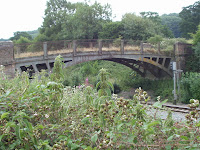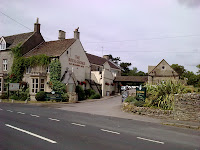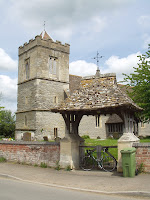I left the office in Hucclecote and headed for Upton St Leonards. Often at this point, I would head uphill towards Painswick but not today. Today I head out through Matson and on to Brookthorpe, cross Stroud Road and into the village of Haresfield. About 10Km into the ride already, time to find a village church, fortunately Haresfield has one of them but it is a little bit hidden.
 Hidden, in fact up track that has a large steel gate and a (small) sign declaring private road in quite big print and access to church and old vicarage only in smaller print. I venture through the gate. This is all indeed shown as a road and public path on my OS map. However, it is stunningly beautiful and, in my submission, unwelcoming at the same time. So to my grumble of the day. If the Church of England is interested in attracting new members, then surely this is the sort of thing they really must stop doing. I appreciate they want to keep the grounds in good condition, which is done really quite successfully, but at the expense of putting people off. The old guard, I'm sure are comforted and possibly made to feel quite sanctimonious by these restrictions. However, they won't be around forever. The 'Keep off the grass', 'Don't let your dog foul', 'Private' and other signs, the gravel drive that appears to be a private drive all conspire to put you off. I felt like a trespasser as I entered through the gate and had to walk my bike, the gravel was far too thick to ride on. I suggest that if it is necessary to keep these buildings purely as historical buildings, then hand them over to (for example) English Heritage and ship the congregation off to a nearby church. There are plenty about and I'm willing to bet none of the congregation walk. If it is intended to be a place of worship, then open it up and employ a good caretaker and groundskeeper.
Hidden, in fact up track that has a large steel gate and a (small) sign declaring private road in quite big print and access to church and old vicarage only in smaller print. I venture through the gate. This is all indeed shown as a road and public path on my OS map. However, it is stunningly beautiful and, in my submission, unwelcoming at the same time. So to my grumble of the day. If the Church of England is interested in attracting new members, then surely this is the sort of thing they really must stop doing. I appreciate they want to keep the grounds in good condition, which is done really quite successfully, but at the expense of putting people off. The old guard, I'm sure are comforted and possibly made to feel quite sanctimonious by these restrictions. However, they won't be around forever. The 'Keep off the grass', 'Don't let your dog foul', 'Private' and other signs, the gravel drive that appears to be a private drive all conspire to put you off. I felt like a trespasser as I entered through the gate and had to walk my bike, the gravel was far too thick to ride on. I suggest that if it is necessary to keep these buildings purely as historical buildings, then hand them over to (for example) English Heritage and ship the congregation off to a nearby church. There are plenty about and I'm willing to bet none of the congregation walk. If it is intended to be a place of worship, then open it up and employ a good caretaker and groundskeeper. Rant over, the Church of St Peter is a stunning church dating back to 12th century and an incredibly impressive 15th century range of buildings that comprise the old vicarage and would, 500 years ago, no doubt have isolated the church even then as being above the common man. (Sorry I said rant over). The church comprises of comprises nave, chancel of two compartments, west tower and spire, and north and south porches. Some of the original 12th century fabric still exists including decoration and ornamentation over the north doorway and north walls. The church was rebuilt in the 14th century when the west tower with a spire, gargoyles, and a staircase turret on the north, and the porches were added. In the mid 18th century, the church was re-roofed and repairs carried out on the tower and spire. Interior restoration later in the 18th century led to accusations that some ancient details. Something must have gone wrong at some point as it was described in 1841 as 'unwholesome, uncomfortable, and squalid'. This led to a thorough restoration in the next year.
Rant over, the Church of St Peter is a stunning church dating back to 12th century and an incredibly impressive 15th century range of buildings that comprise the old vicarage and would, 500 years ago, no doubt have isolated the church even then as being above the common man. (Sorry I said rant over). The church comprises of comprises nave, chancel of two compartments, west tower and spire, and north and south porches. Some of the original 12th century fabric still exists including decoration and ornamentation over the north doorway and north walls. The church was rebuilt in the 14th century when the west tower with a spire, gargoyles, and a staircase turret on the north, and the porches were added. In the mid 18th century, the church was re-roofed and repairs carried out on the tower and spire. Interior restoration later in the 18th century led to accusations that some ancient details. Something must have gone wrong at some point as it was described in 1841 as 'unwholesome, uncomfortable, and squalid'. This led to a thorough restoration in the next year.Curiously, right next to the church on the East side, there is moated site, known as The Mount. A square moat encloses an island measuring approximately 50m by 48m. The motte at the centre now only stands 1.5m high but was previously recorded as 10ft high. The moat is 10 to 16m wide and 3-4m deep. The moat is believed to be the site of the manor house of Haresfield which was still standing in 1680. From my position, it was difficult to see anything on the mount. I would have to do that by foot along one of the many converging footpaths.
A kilometre or so south(ish) from Haresfield is a railway bridge that now looks rather sorry for itself, I have linked to this on the location link that you should see at the bottom of the blog. A look at the OS map suggests that this would at one time been a road link towards Stonehouse and the area east of the railway line. I'm no expert on railways or bridges, but I guess that this is industrial revolution type era so quite a change in the politics of the area. The bridge now just leads to a farm.
 Carrying on, heading east, next stop is Standish. On the approach, you get an excellent view of the grade II listed village hall and 14th century church of St Nicholas. Despite the church you can now see having been built in the 14th century, it is believed to have replaced a wooden Saxon church. The church is grade I listed and restored in the 1860s. Legend has it that the body of Edward II was brought to Standish church in 1327 on its way to being interred at Gloucester Cathedral. A much more reliable historical reference can be found inside the church. At the end of the 16th century, Sir Henry Winston was Lord of the Manor of Standish; his memorial in the church bears a 20th century sign:
Carrying on, heading east, next stop is Standish. On the approach, you get an excellent view of the grade II listed village hall and 14th century church of St Nicholas. Despite the church you can now see having been built in the 14th century, it is believed to have replaced a wooden Saxon church. The church is grade I listed and restored in the 1860s. Legend has it that the body of Edward II was brought to Standish church in 1327 on its way to being interred at Gloucester Cathedral. A much more reliable historical reference can be found inside the church. At the end of the 16th century, Sir Henry Winston was Lord of the Manor of Standish; his memorial in the church bears a 20th century sign: "This monument to Sir Henry Winston was restored to commemorate the marriage in 1618 of his daughter Sarah to John Churchill from which union descended Sir Winston Churchill K.G. O.M. C.H. M.P. 1874-1965 Prime Minister 1940-1945 . 1951-1955"
"This monument to Sir Henry Winston was restored to commemorate the marriage in 1618 of his daughter Sarah to John Churchill from which union descended Sir Winston Churchill K.G. O.M. C.H. M.P. 1874-1965 Prime Minister 1940-1945 . 1951-1955"This Sarah Winston's grandson became the first Great Duke of Marlborough, ancestor of Sir Winston.
 In the grounds of the church are, probably, 14th century vicarage buildings that are now used as community and parish offices (I believe). The openness and use of this church strikes a stark contrast to that at Haresfield whilst losing absolutely nothing of its majesty.
In the grounds of the church are, probably, 14th century vicarage buildings that are now used as community and parish offices (I believe). The openness and use of this church strikes a stark contrast to that at Haresfield whilst losing absolutely nothing of its majesty.
To the west of the church is, as the map says, a gateway. This is, in fact, a very impressive ruined gatehouse leading to Standish court and to a house built by Abbot of Gloucester, probably dating from the 14th century. Sadly, beyond this point is private land.
The village of Standish is in fact a little bit of a misnomer. It is a small scattered parish of less than 100 households spread out along 2 miles of the main road between Stonehouse and Gloucester. It has no shop, no post office, no school and no pub. So you're unlikely to meet my brother there.
And so I start to head north back towards Gloucester. Stopping off at Moreton Valence and the church of St Stephen. The nave and chancel are early 12th century, the tower 15th century followed by the south aisle. A bit of a varied management as no vicarage was ever established in Moreton Valence. The parish changed hands between Standish and Moreton and Whaddon before the Bishop of Gloucester joined it with Whitminster in 1961. Most of the curacy lived in other parishes. One notable exception being the 1570 curate John Day. He obviously didn't ingratiate himself to the parishoners having been described as 'to be 'no peacemaker, of late a weaver, ... a drunkard and an unruly man who put his pigs into the churchyard. Perhaps the church needs more people like that?
Alongside the church is another moat. A bit of a theme here I feel. Again, not expected but another photo opportunity. This is thought to be the site of a fortified manor house, the hall built by William de Valence in 1253. It was documented again in 1324 but was probably in a state of disrepair by 1372. No evidence has been found to support the traditon that this is the site of a castle.
From here, the journey back to Barnwood could be a straight ride up the A38 but I have time on my hands. So, without further stops, I cross over the canal and take a trip round Epney and Longney, again some beautiful, quiet well surfaced roads, a pleasure to ride on. Dropping back over the canal at Hardwicke, through Quedgeley and onto the new(ish) bypass. The canal was rerouted for the bypass, although they still bridged it, but this is a long reasonably straight pan flat road where one can be quite satisfied with a reasonable turn of pace for relatively little effort. From here, I drop onto the inner ring road, onto Estcourt Road befor heading north into Longlevens and picking up the cycle path into Barnwood.
Total distance - 46 KM
Average Speed - 29.5 KM/h
Weather - about 23C, Dry, wind from NW, about 5 KM/h













































